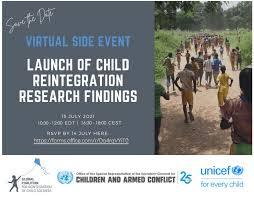
https://childrenandarmedconflict.un.org/2025/05/release-of-new-publicati...
In 2024, close to 16,500 children were released from armed forces and armed groups and received reintegration support, but over 7,000 children were newly recruited and used in combat and support roles by parties to conflict that same year. These numbers underline the criticality of one lifeline for these children, if we are to avoid any chance at re-recruitment: their return and reintegration back to civilian life once they are released and separated from armed forces and armed groups, which is at the core of a new publication released today.
In 2018, the Special Representative of the Secretary-General for Children and Armed Conflict Ms. Virginia Gamba, identified a gap in the prevention of re-recruitment of child soldiers and embarked on a reintegration-focused journey with the ambition to re-galvanize momentum around the criticality to invest in reintegration programs beyond the humanitarian spectrum, across the Humanitarian-Development-Peace (HDP) nexus. “When I was appointed SRSG-CAAC, I realized that reintegration was not only a humanitarian necessity, but also a critical phase for both the protection of millions of children and the prevention of grave violations against them. Child reintegration has significant potential for conflict prevention and is a strategic investment to foster peaceful societies and build long-term, sustainable peace,” she said.
The Special Representative’s Office, in collaboration with UNICEF and civil society partners, developed innovative partnerships and spearheaded multitrack workstreams to bring refreshed perspectives and approaches to the issue of child reintegration. Among the key initiatives feature the creation of a Global Coalition for the Reintegration of Child Soldiers, co-chaired by the Special Representative and UNICEF and launched with Her Majesty Queen Mathilde of the Belgians, the Financing Innovation Forum and the “Nairobi Process of former children associated with armed forces and armed groups (CAAFAGs)”. On their side, Member States supported the initiative throughout and formed a Group of Friends for Reintegration co-led by France, Kazakhstan, and Malta that provided important initial political support.
The present publication captures the work, outcomes, and achievements of the multiple stakeholders who have been involved in the various aspects of this initiative. The publication also makes the case for a more strategic consideration of the criticality to adequately support child reintegration across the HDP nexus. “Children are resilient. Children are agents of change and peace. There is no more strategic and economically beneficial way to invest in long-term peace than providing timely, adequate, predictable and sustainable reintegration support to children formerly associated with armed forces and armed groups. These children are a strategic cohort for long-term peace and security. If we succeed in an annual doubling of children released and reintegrated and halving those recruited, we will soon significantly reduce the use and abuse of children for, by and in armed conflict,” concluded Ms. Virginia Gamba.
The report is available digitally on the website of the Special Representative’s Office via this LINK
***
Fore more information:
Ariane Lignier, Communications Officer, Office of the Special Representative of the Secretary-General for Children and Armed Conflict: ariane.lignier@un.org
Fabienne Vinet, Political Affairs Officer, Office of the Special Representative of the Secretary-General for Children and Armed Conflict: vinet@un.org









